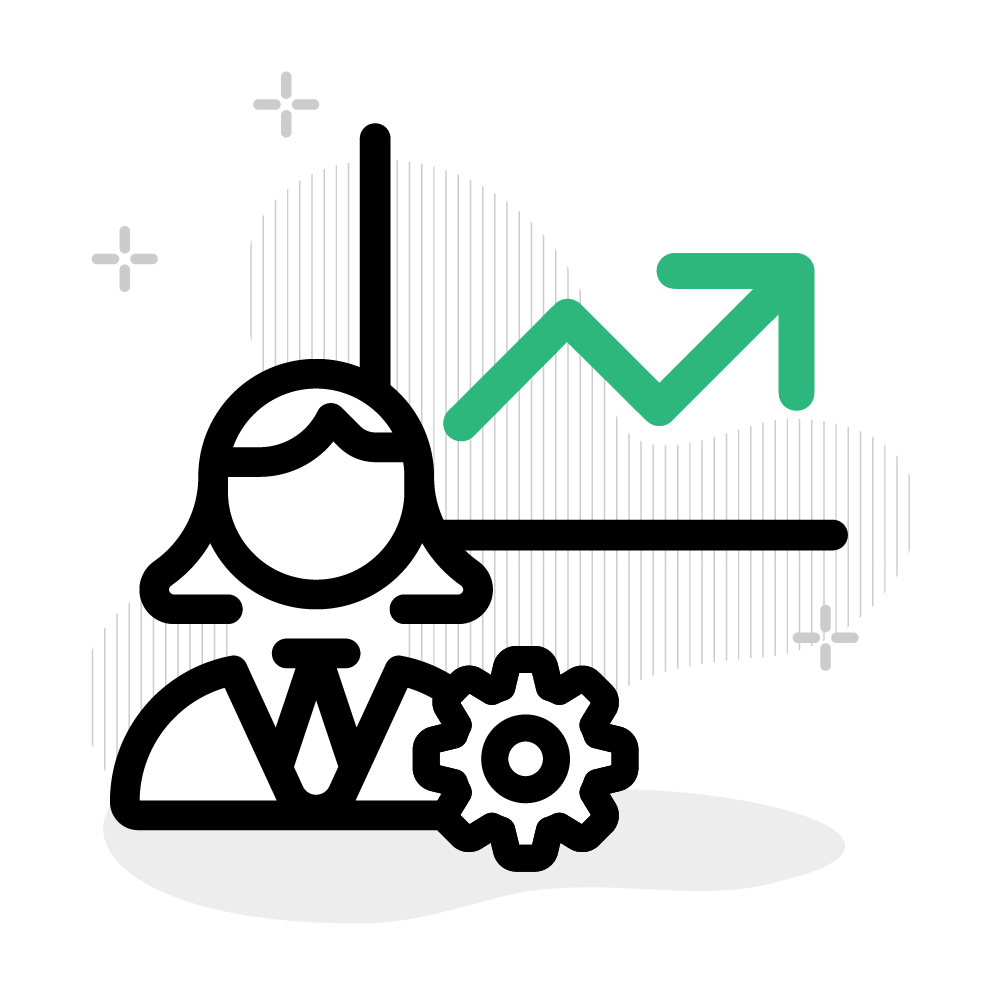Key Findings
- The average worker is only productive for two hours and 53 minutes per day
- Reading news sites is the number one most unproductive activity at work
- We spend 12 minutes on tasks before we’re interrupted
- It takes 23 minutes to refocus on a task
- We spend over two hours procrastinating daily
- Workers with flexible conditions are up to 39% more productive
- Rewarding workers can make them 20% more productive
How Productive Are We, Exactly?
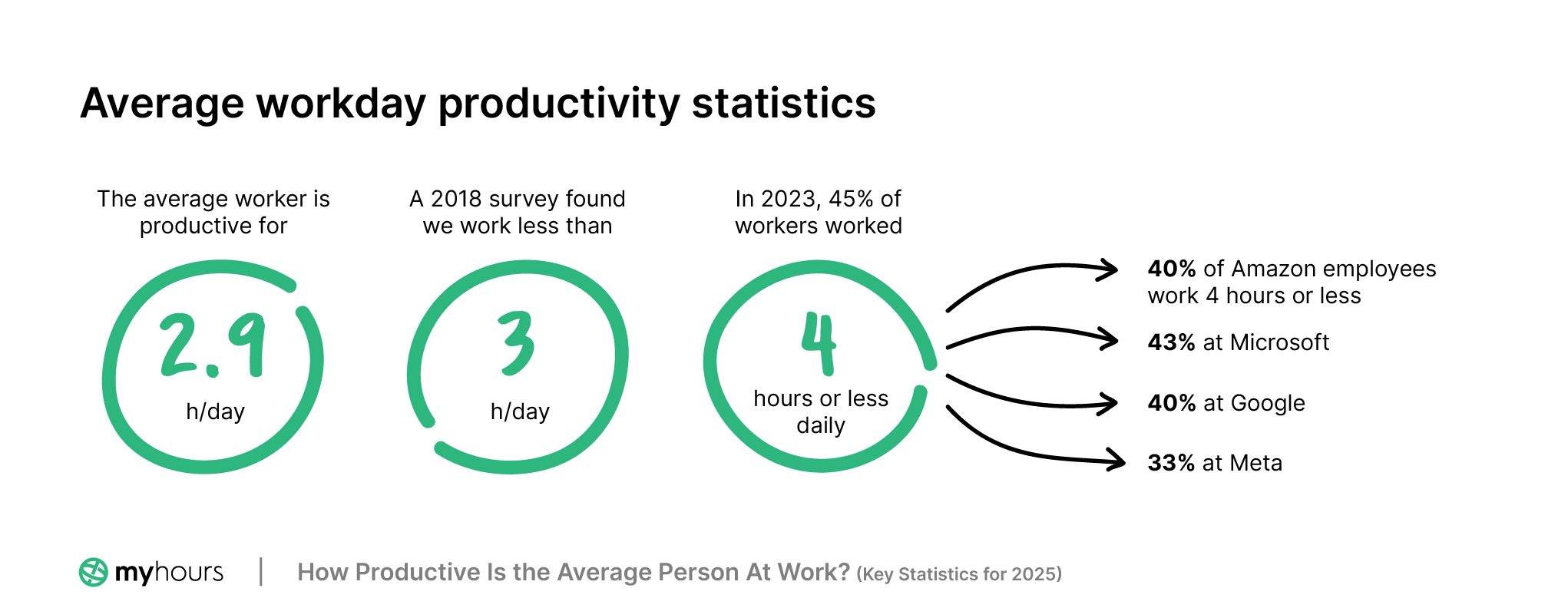
The average worker is only productive for two hours and 53 minutes per day. (VoucherCloud)
Yes, you read that correctly!
In 2018, VoucherCloud conducted a survey that concluded we spend less than three hours out of an entire workday actually working.
Although the VoucherCloud survey is now a few years old, it doesn’t look like much has improved:
In 2023, 45% of workers said they work 4 hours or less a day (Worklife)
It doesn’t really make much difference where people work, either. The results are similar
According to the same Worklife survey:
- 40% of Amazon employees worked four hours or less per day
- For Microsoft, the percentage rose to 43%
- 40% of Google employees also clock in four hours or less
- Meta seemed to do a little better with only 33% working less than four hours
On the other hand,
Employees were +8 mins/day more productive in the first half of 2023 vs. the second half. (ActivTrak)
That doesn’t sound like much but if you take an employee on a $60k salary and multiply by 1,000, that extra 8 minutes accounts for:
- The workload capacity of 18 full-time employees
- A value of $1.1 million
So, what are we doing with the rest of our time? And why are we struggling to be more productive?
Considering the average 8-hour workday, it seems we are experiencing a lot of time sinks.
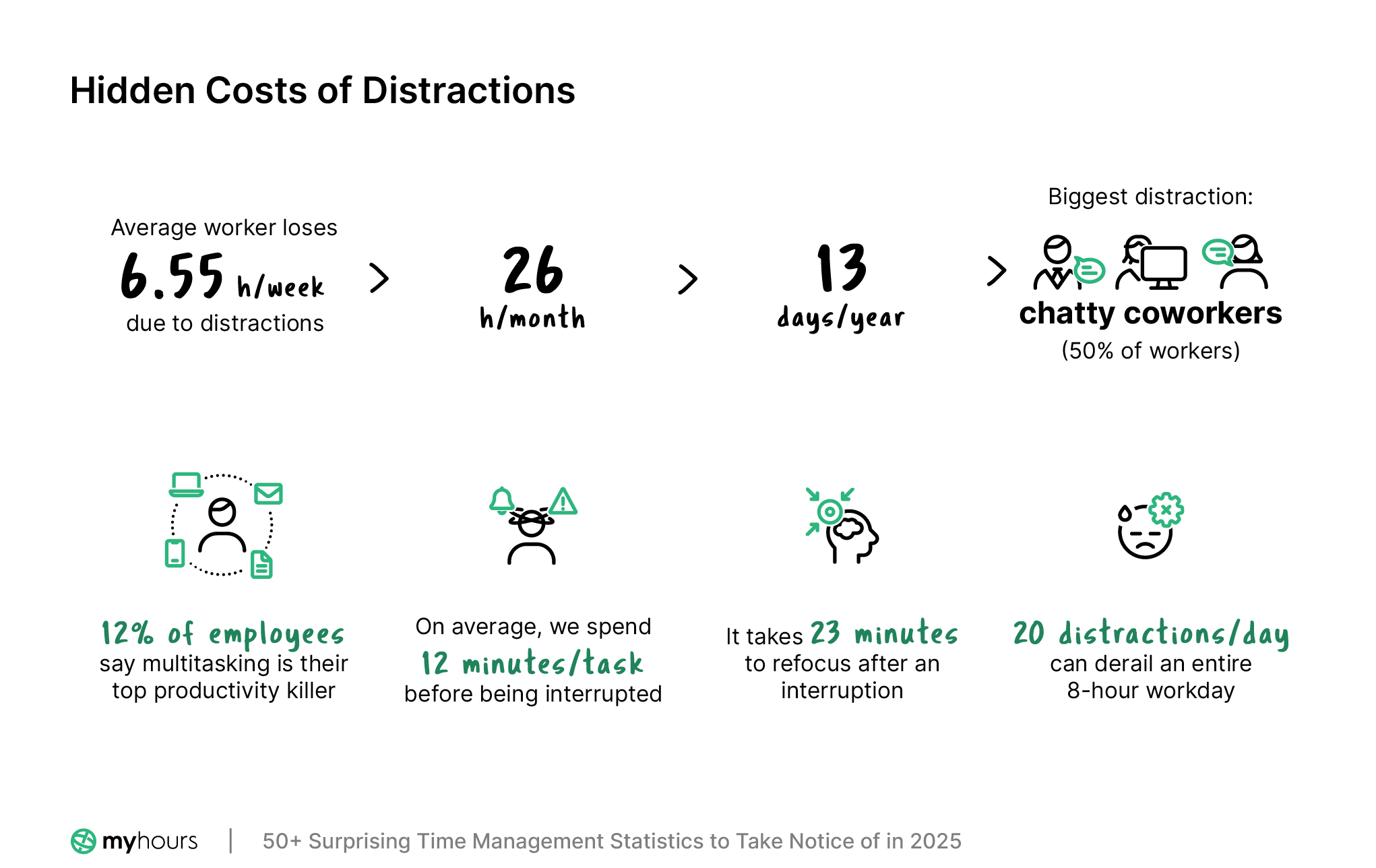
In 2023, an average of 6 hours and 33 minutes per worker were lost weekly in the US due to distractions. (Workamajig)
That amounts to 26 hours per month or 13 days per year!
Multiply that across 100 workers and an organization loses 1,300 days annually.
The biggest culprit? Chatty coworkers with a whopping 1 in 2 working Americans considering them their main distraction in the office
According to the same extensive 2023 survey,
12% of employees listed multitasking as their top productivity killer.
This stands to reason since it is well documented that multi-tasking is a physical impossibility. Our brains simply cannot focus on more than one thing at once.
What we end up doing is task-switching, where we rapidly shift from one task to another without giving any of them our full attention.
Other workplace factors that halted the workflow included:
- Boredom (10%)
- Personal problems (9%)
- Feeling overwhelmed by workplace changes (7%)
- Smoke breaks (7%)
- Snack breaks (5%)
- Fire alarms (2%)
We spend around 12 minutes on a task before we're interrupted. (University of California)
Worse still, it takes over 23 minutes to fully refocus… before we’re interrupted. Again.
For an average 8-hour workday, it, therefore, only takes 20 distractions before we’ve lost focus for the entire day.
According to the research, the type of distraction doesn’t really matter. Once focus is lost, regardless of the reason, we struggle to regain it.
Those who work remotely are not immune, either, and can suffer from some interesting distractions.
Over 21% of remote workers find their attention is regularly diverted by household chores (Workamajig)
Going back to the Workamajig survey on workplace distractions, it was found that another 17% of home workers got interrupted by household members.
Even the family pet disrupts, with 12% of people regularly getting up from their desk to attend to their furry friend!
Weirdly, seasonal interruptions are also a “thing:”
- All males and Gen Z females (18-24) said that Halloween is the second most distracting holiday after Christmas.
- Gen Z males (age 18-24) said that the annual Apple Event was just as distracting as the holidays.
- Anyone aged 54+ finds New Year's Day and Christmas the most distracting.
Let’s move on to procrastination. There have been no significant recent studies on this subject that we can find. However, there are two interesting ones from pre-2020 that we wanted to highlight:
In 2018, 72% of US and Canadian people admitted to procrastinating at least sometimes. (Fidelity Financial)
This is compared with just 5% of people who say they have never procrastinated.
While the survey was aimed at procrastination around financial management, it was found that regardless of the reason, procrastination was strongly linked to feelings of stress and shame.
When asked how procrastination made people feel:
- 41% said they feel stressed out
- 33% said it was just part of life
- 24% said they feel ashamed
In 2019, UK workers wasted up to 2 hours and 9 minutes each day procrastinating. (Music Magpie)
What did the survey find that we do while we’re procrastinating?
- The most popular activity was to sit there and daydream. We waste about 20 minutes doing that.
- Collectively, we also liked to spend around 18 minutes gossiping.
- Contrary to popular belief, men were found to be the biggest gossipers, clocking up to 22 minutes per day compared to 15 minutes for women.
- However, women were most likely to read the news and spent about 20 minutes doing that.
Workers in the wellbeing and beauty industry were the biggest procrastinators and spent 46 minutes gossiping, 38 minutes on Facebook, and 45 minutes messaging.
In contrast, those who worked in agriculture were the least likely to procrastinate and spent only around 57 minutes per day wasting time.
Unproductive chat messages typically consume 40 minutes per day (Economist)
This accounts for around 50% of the time that workers are using chat tools.
The cost of this lost time adds up – to the tune of $18,000 per worker annually.
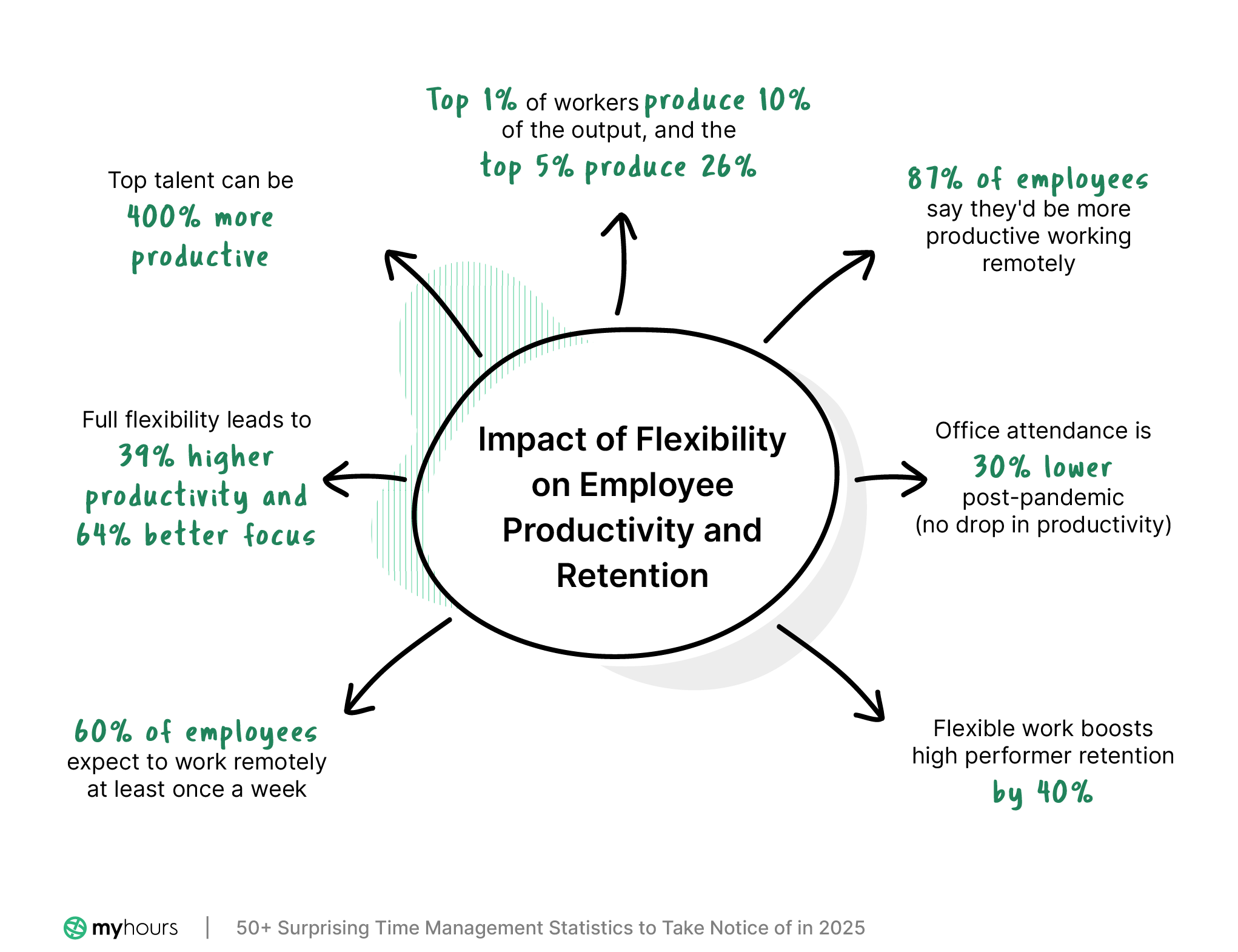
High-quality talent can be up to 400% more productive than average employees across various fields (McKinsey)
In complex occupations, such as software development, top performers can be as much as 800% more productive than their average counterparts.
It’s not easy to find, though, with over a third of leaders saying that recruiting top talent is their biggest challenge.
Organizational productivity tends to follow the Pareto principle (Forbes)
The Pareto Principle, also known as the 80/20 rule, states that roughly 80% of effects come from 20% of causes.
In the workplace, a small minority produces a significant proportion of the overall output.
Data indicates that:
- The top 1% of workers produce 10% of the output, and
- The top 5% produces 26% of the output
87% of employees felt they would be more productive if they worked their desired number of days at home (McKinsey)
Post-pandemic after remote working became the norm, people still want it to remain that way. Office attendance remains 30% lower than it was before the pandemic despite organizations pushing for people to return.
Studies conducted by companies and research institutions found no negative relationship between hybrid work and productivity.
So, really there is no reason to insist that workers go back to an office environment.
Here’s a statistic to support that:
Employers that implement high or “radical” workplace flexibility enjoy a 40% higher retention of high-performing staff (Gartner)
Employees want to feel autonomous and in charge of their own working hours. Employers that implement flexibility will attract and retain top talent.
The desire for a flexible workplace isn’t going anywhere:
- 60% of employees expect to work remotely at least once a week
- Both white-collar and non-white-collar employees want similar rates of flexibility and more flexibility than they are currently given
Workers who have full flexibility are reporting 39% higher productivity and 64% greater ability to focus (Future Forum)
Compared to workers with flexible schedules, employees with rigid work schedules say they are:
- 2.5x more likely to “definitely” look for a new job
- 4.6x more likely to suffer from work-related stress and anxiety
- 2.6x to have a worse work/life balance
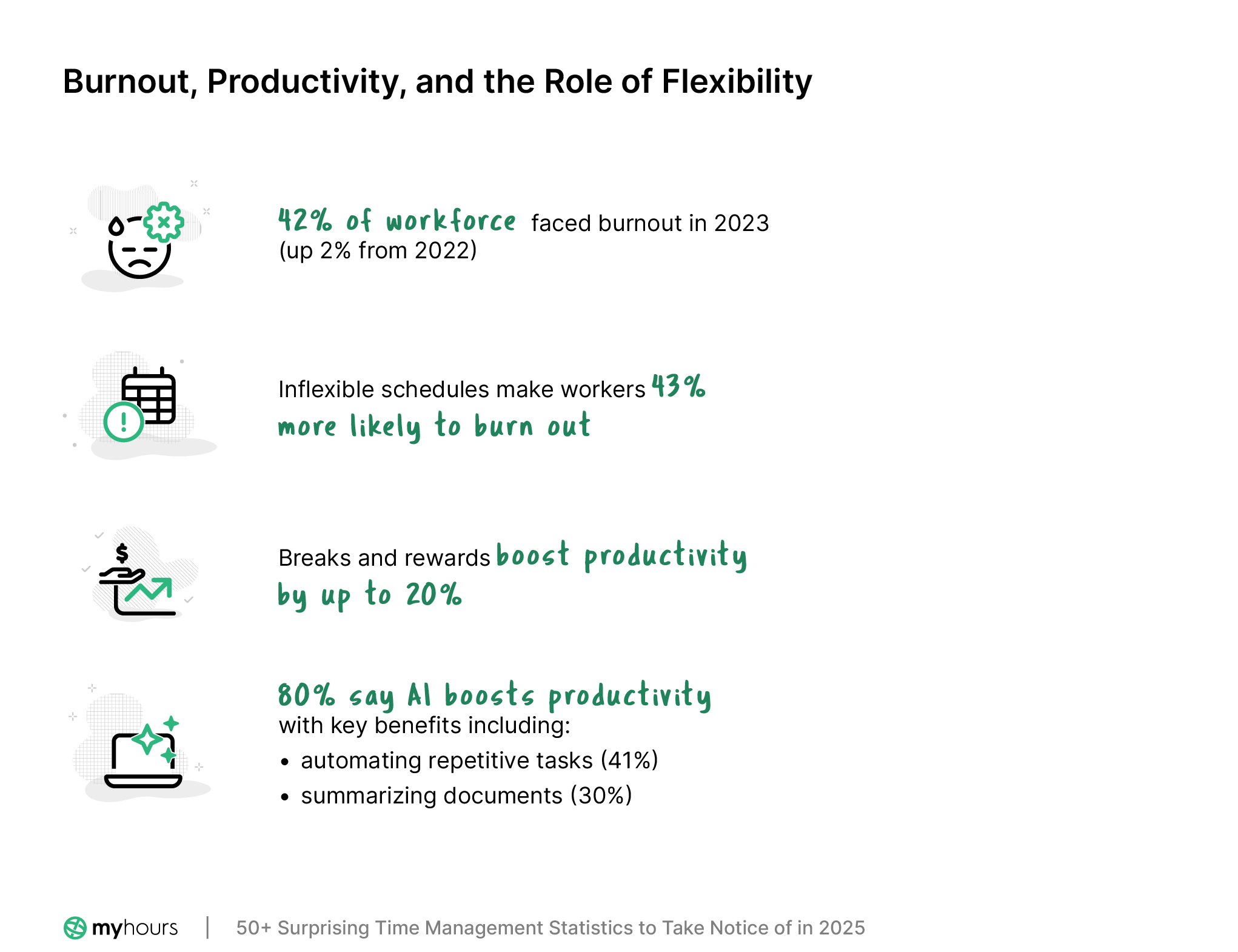
In 2023, 42% of the workforce experienced burnout – a rise of 2% from the previous year (Future Forum)
Employees who are dissatisfied with inflexible working schedules are 43% more likely to say they are suffering from burnout compared with more flexible workers.
Burnout has had a significant impact on cognitive ability and productivity (Taylor and Francis)
A study carried out in 2021 across 730 burnout-suffering individuals found interesting results.
Clinical burnout resulted in significant impairments in
- Episodic memory
- Short-term and working memory
- Executive function, attention, and processing speed
- Fluency
Despite the idea that working harder increases productivity, the results suggest otherwise. The more burned out we become, the less able we are to use our brains efficiently.
Therefore, take breaks when you need them and time to recharge the batteries.
Rewarding workers can make them 20% more productive (SMF)
During one study, workers were rewarded with snacks and drinks after which a 20% uptick in productivity was observed.
Additionally, employees who were made happy before they started working increased their productivity by as much as 12%.
80% of workers say that using AI increases productivity (Economist)
AI is here to save us from unproductive tasks. And, it’s true, it has the capability to remove boring and repetitive jobs from our daily work days.
Here’s what people think of it:
- AI has improved their productivity at work (79%)
- AI reduces the time spent on repetitive tasks (75%)
- AI improves the quality of their work (73%
The biggest reasons why people feel that AI increases productivity is because it:
- Automates repetitive tasks (41%)
- Summarizes documents (30%)
Final Thoughts
Turns out, there’s a lot that gets in the way of our productivity.
The key is finding ways and methods to help improve our work day and minimize distractions.
One way is to use time-tracking software. Once we understand where our day is going, we can pinpoint the problem areas and work to improve them. Then, we can spend more time on the things that matter.
Sources
- VoucherCloud: Productivity Survey 2018
- Worklife: Nearly half of workers say they work 4 hours a day
- Workamajig: Top distractions at work killing productivity in 2023
- University of California: The Cost of Interrupted Work: More Speed and Stress
- ActivTrak: 2024 State of the Workplace report
- Fidelity Financial: 2018 Procrastination Study
- Music Magpie: Paid to Procrastinate
- Economist Impact: Search of Lost Focus 2023
- McKinsey: Attracting and Retaining the Right Talent
- Forbes: How Many Star Employees Do You Really Have?
- McKinsey: How hybrid work has changed the way people work, live, and shop
- Gartner: The Secret to Productive Employees
- Future Forum: Pulse Report 2023
- Taylor and Francis: Cognitive function in clinical burnout
- Social Market Foundation (SMF): Happiness and productivity
